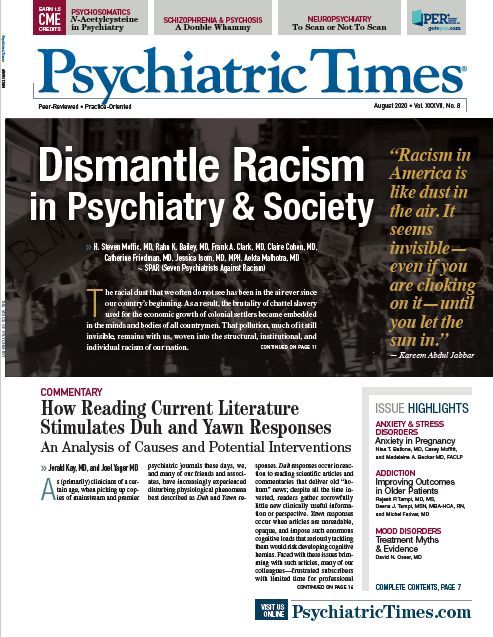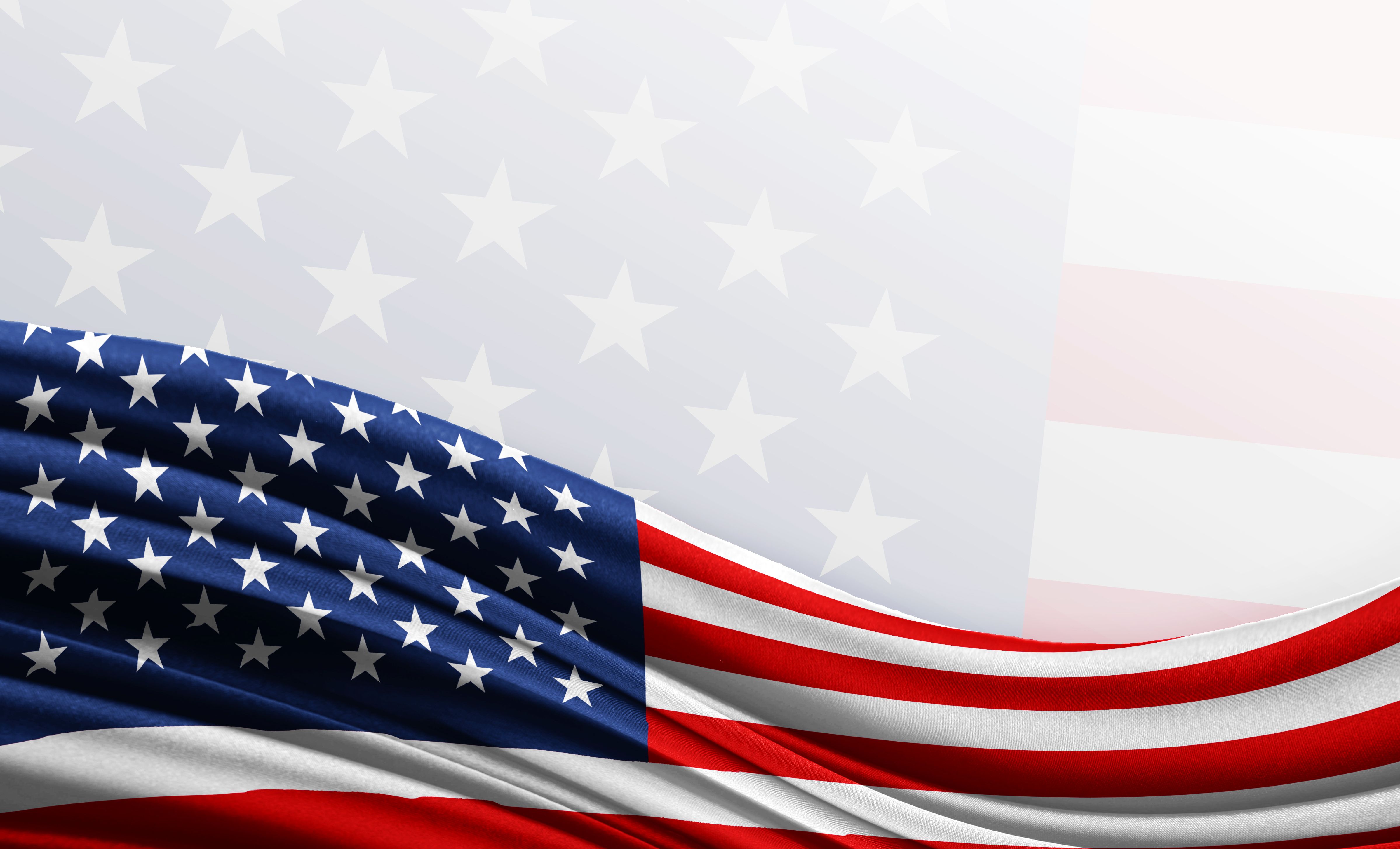Publication
Article
Psychiatric Times
Dismantle Racism in Psychiatry & Society
Author(s):
Psychiatrists should be experts at hearing and seeing what is not visible. That is exactly what we need to do to let the sun shine through the racist dust.
Shweta/AdobeStock
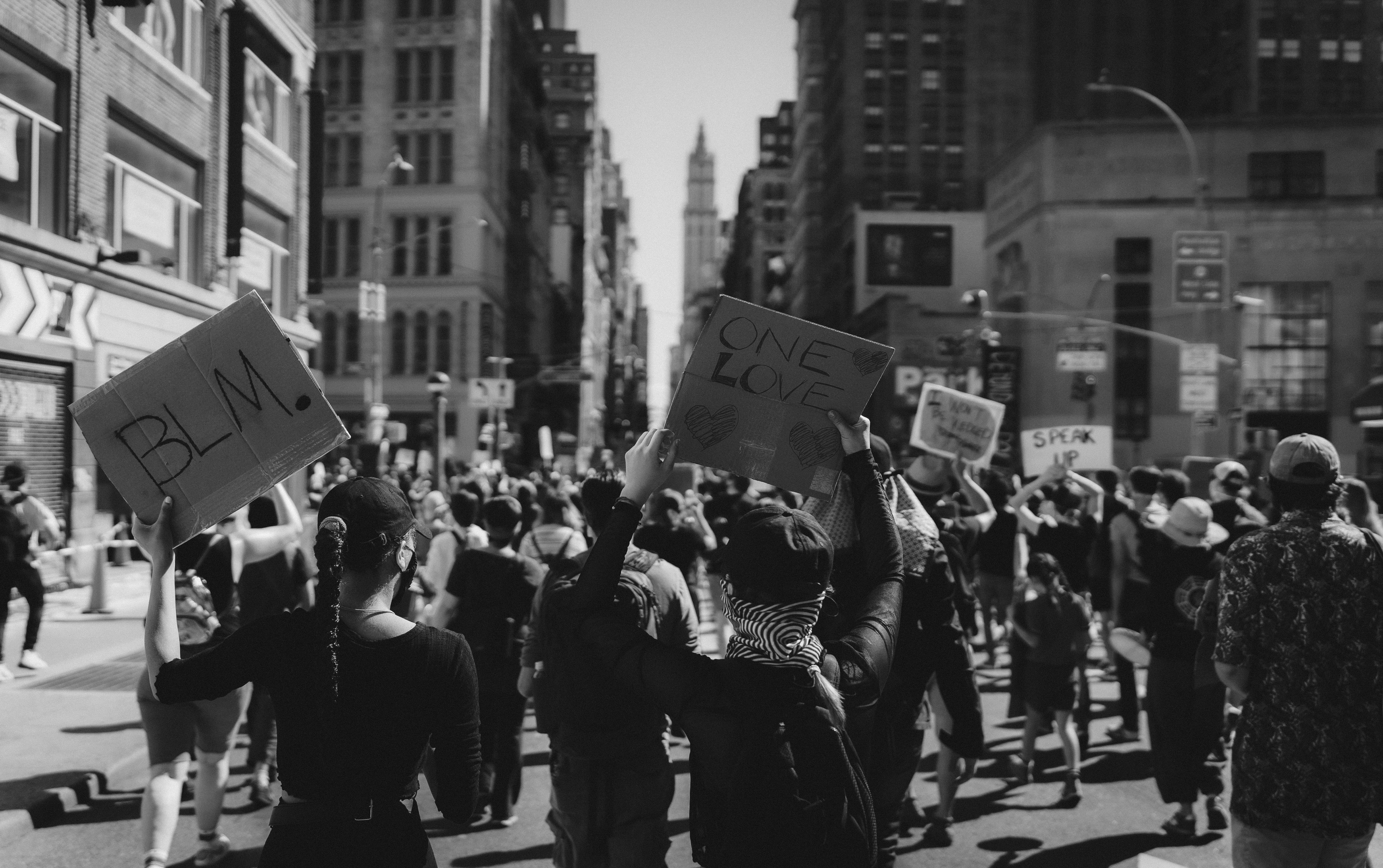
“Racism in America is like dust in the air. It seems invisible—even if you are choking on it—until you let the sun in.” — Kareem Abdul Jabbar
~ SPAR (Seven Psychiatrists Against Racism). To join the upcoming webinar, click here.
The racial dust that we often do not see has been in the air ever since our country’s beginning. As a result, the brutality of chattel slavery used for the economic growth of colonial settlers became embedded in the minds and bodies of all countrymen. That pollution, much of it still invisible, remains with us, woven into the structural, institutional, and individual racism of our nation.
Psychiatrists should be experts at hearing and seeing what is not visible. We are taught to listen with a third ear for hidden or unconscious meanings. We look to nonverbal messages to understand what is not stated. And that is exactly what we need to do to let the sun shine through the racist dust. We have to use racial hearing aides and racial visual lenses so we do not forget to look for the racism. We need to leverage our experiences to improve the experiences of those who come after us.
Antiracism as an ethical priority
This is one of those times that try our souls. Or should try our souls—psychiatrists and everybody else.
You may recall those paraphrased words of Thomas Paine during other revolutionary times. In 1776, George Washington rallied his freezing and faltering troops, and the United States went on to win the war of independence. However, not everybody received the promised freedom of independence. African Americans did not. With the deaths of Mr George Floyd and others as well the persecution of so many others, we have been tragically reminded that we are still trying to unite and win the 400-year war against racism and discrimination. This unfortunate truth has been made clear not only by the recent police tragedies but also the overrepresentation of minorities among pandemic deaths, the destruction from climate-related disasters, and the continued urban gun violence.
The American Medical Association’s Principles of Medical Ethics states, “A physician shall recognize a responsibility to participate in activities contributing to the improvement of the community and the betterment of public health.”1 Since racism harms everyone, from the victims to the perpetrators, and causes harm on multiple levels, we are ethically bound to address and reduce in order to improve public health and better our communities.
The history of racism in psychiatry
Psychiatry’s history in addressing racism has been spotty at best, sometimes promoting advances and sometimes stagnating, even in surprising places. Benjamin Rush, MD, (1745-1813) often called “the father of American psychiatry,” exemplifies the twists and turns of psychiatry’s stand on racism. Rush was an abolitionist, even though he owned a slave. In fighting for freedom for African-Americans, he also developed the diagnostic theory of “Negritude,” which was considered to be similar to a mild form of leprosy. The only cure for this disorder was to become white.2 (A possible medical explanation for this hypothetical genetic defect was that it was the fairly rare disease of vitiligo, in which the skin loses its pigment and appears to get lighter.) Do the good deeds make up for the racist actions?
Meanwhile, the field did not see the first Black psychiatrist, Solomon Carter Fuller, MD, until around 1900, more than 50 years after organized psychiatry began in the United States. Gradually, the numbers of Black psychiatrists grew and contributed their expertise to the field, including efforts to address racism. These psychiatrists introduced ideas like labeling the psychological and health effects of interpersonal racism via the concept of microaggressions. Their targeted literature contributions led to a reduction of the misdiagnosis of Black Americans.3 And, psychiatry had to wait until 2019 before it saw its first Black president—Altha J. Stewart, MD.
Despite the small advances, there have been difficulties and hurdles. Black psychoanalysts experienced challenges while navigating institutes that deemed Black patients as unanalyzable and weaponized theory to perpetuate racist stereotypes. Many of these psychiatrists had to make Campbellian heroic journeys to overcome racial obstacles along the way.4
Unfortunately, these microaggressions are still common. Despite her experience, expertise, and position of authority in psychiatry, Danielle Hairston, MD, director of psychiatry residency at Howard University, noted she is still routinely questioned and doubted. She shared this experience of a white colleague ignoring her at a patient’s bedside5:
“He’s like, oh, well, the psychiatrist will be here to speak to you soon. And I was like, I’m right here. And he’s like, oh, my gosh. Like, I thought you were the sitter. And he’s like, oh, my God; I don’t know why I said that. And I was like, oh, it’s because I’m Black. And I don’t even necessarily think that he’s racist. It’s just that that’s the bias.”
The APA is not the only psychiatric organization that has missed the boat. Not only has the American Association of Community Psychiatrists (founded in 1985 and recently renamed as the American Association for Community Psychiatry), not had a Black president, it has not had one of any ethnic minority of color background. Yet, it is generally considered to be more liberal than the APA.
Similar racial challenges and contributions emerged for psychiatrists outside of the United States. The most prominent international Black psychiatrist was Frantz Fanon, MD, who practiced in Tunisia and Algeria in the 1950s.6 He espoused that colonialism had a direct negative psychic effect and that the political and psychic are intertwined. To address this with his patients, he came up with the concept of institutional psychotherapy, meaning the environment and activities of an inpatient ward should be culturally congruent and positive.7
Leveraging psychiatry to understand and address racism
Fanon’s ideas help us to understand the 3 main centers of racism in the US. His work on institutional psychotherapy highlighted 1 of the 3 centers; the others are structural and personal. All of these can have different degrees of intensity and prevalence. Institutional racism, which Fanon aimed to address, involves institutions’ policies, practices, and procedures that have a disproportionately negative effect on minorities’ access to quality goods, services, and opportunities. Structural racism relates to how it is imbedded within every aspect of the country as a consequence of chattel slavery more than 400 years ago. Internalized personal racism reflects the finding that we all have some degree of racism as a consequence of structural racism, some of which is unconscious and can be discovered by taking an Implicit Bias Test and/or feedback from others.8
All 3 of these centers of racism can be addressed in various ways. From the very first model curricula on cultural psychiatry education for residents in training, self-reflection of one’s cultural background has been deemed essential in psychiatry.9 Even so, the onus is on those with the most power, which means so-called white-Americans who have benefitted from the unearned advantages captured by the term White privilege. (Interestingly, intermittent attempts to psychopathologize severe racism as a DSM disorder have failed thus far, in part due to disagreements on where to draw the line.10) We can address institutional racism by improving educational settings, policies, and our own psychiatric systems. Since these mechanisms for racism can contribute to poorer care of Black patients, especially by non-Black psychiatrists, it is essential that the field addresses them. (To learn more, it is helpful to read the allegorical gardener’s tale by Camara Jones, MD, PhD, MPH.11)
Black patients and psychiatrists are not alone in facing racial-ethnic disparities. Other minority groups, especially Native Americans, have also been affected. Why do these disparities and racism tendencies exist? The disparities may reflect our hard-wired brain tendencies of human nature to fear those who seem different, which contributes to tribalism and our modern ingroups. This reaction is almost like a psychological immune system but, like the physical immune system, it can go awry at times. When it does, it provides a substrate for racism, Islamophobia, anti-Semitism, and related group discriminations. Moreover, we tend to project our inadequacies onto others, scapegoating them in an attempt to feel better and gain power.
The solution, therefore, lies in our prefrontal cortex and our ability to think rationally and carefully to control our emotional tendencies and reframe our thinking, as is done formally in cognitive behavioral therapy.12 For optimal antiracist impact, we must start with parents and their children,13 and use the tools currently at our disposal.
Clinical care and racism
All things considered, Black patients more often trust Black clinicians than those of other races. Unfortunately, Black patients have a much smaller chance than white or Asian-American patients of finding culturally similar clinicians. Whenever there is a cross-cultural match of patient and physician, building a positive therapeutic relationship is that much more important. In addition to providing welcoming access, careful evaluation, and appropriate treatment, this also necessitates making race and racism an open and accepted topic to discuss. Similarly, when staff and leadership reflect the cultures of the patients and communities, it sends a comforting message. Inservice training on racism should be ongoing to further promote a welcoming and appropriate environment. Moreover, the patient’s preferences in terms of racial and cultural terminology should dictate how things are discussed. Whenever the alliance is not going well, consultation with colleagues from the treatment team with a similar background can be helpful.
These words from Kai Koeber, who survived the Marjory Stoneman Douglas High School in Parkland, Florida, massacre, put this ideal into perspective14: “Finding a Black therapist really saved me some time, and there was more connection, in terms of the kinds of struggles that I might feel or the kinds of ways I might think about certain scenarios.”
Similarly, trauma-informed care is a necessity. Primary trauma is common in Black patients and clinicians; secondary trauma is common in non-Black clinicians. Often, that trauma is embedded not only in our minds, but also in our bodies. Ta-Nehisi Coates, a national correspondent, put it succinctly: “But all our phrasing . . . serves to obscure that racism is a visceral experience, that is dislodged brains, blocks airways, rips muscle, extracts organs, cracks bones, breaks teeth. You must never look away from this.”15
Finally, outcome studies are crucial to better understand how racism is impacting care. When the setting is multicultural, the outcomes can be compared across races and cultures.
The need for a new unifying vocabulary
A century ago, jazz was among the first activities to combine our different skin hues, explained trumpeter Wynton Marsalis, arguably the most prominent jazz spokesperson. It also provided a new approach to music and new sounds. He understood that there is unity in diversity.
Just as jazz gave us a new musical vocabulary, it is clear we need to review our words and nomenclature to help address racism. Certain words with negative or positive connation are tied to color and, in turn, subconsciously impact racist views. Consider, for instance, terms like blackmail and its negativity versus white knight and its positive connotation. Similarly, how words are treated have an impact. Issues like what words should be capitalized and when they should be capitalized can further impact feelings, as discussed in a recent contentious New York Times article that generated hundreds of comments.16
Technically speaking, we are all people of some color. It took a very small genetic mutation to lighten skin color when, as we now know, the original human beings left Africa. As they moved north and experienced less sunlight, they needed to absorb more of the limited sunshine. This means that, ancestrally, we are all African-Americans. Therefore, embracing the term race, other than the term human race, may be inherently racist.
Composing the piece: integrating the authors
Racism is clearly a psychological and social phenomenon in which a particular group is viewed as superior or inferior to another. Yet, race may not be something intrinsic and immutable, and the judgements and groupings may be a fluid, illusory, imposed, or sometimes insurgent concept. For instance, in World War II, the Aryans touted a so-called “master race.”17 Similarly, the 2020 US Census has a haphazard listing of races: White; Black or African American; American Indian or Alaska Native; Asian; and Native Hawaiian and Pacific Islander. Neither Hispanic or Latino, nor Jewish are listed as a race, but there is a write-in area for “Some Other Race,” acknowledging the fluidity and self-defining nature of the term race.
With that in mind, our challenge is to assemble the various voices to contribute to the dialogue. Accordingly, a multi-racial group of co-authors crafted this piece. Even so, we grappled with how to pull together our expertise and experience, especially since there has been some controversy over who has the right to have a voice in the discussion. At first, we tried to write a typical review article on racism and psychiatry. However, not only was it difficult to come to consensus on some matters, but we found our personal voices got lost. Fortunately, our secondary thinking processes of our reflective egos managed any tension18, which is one of the reasons psychiatry can and should play an important role in this discussion.
Once we decided that each co-author should present on themes important to them, complete with their own race-related terminology, the project moved along quickly. In turn, once our individual voices were preserved, returning to more general themes in the surrounding material was easier. We view this as a model for leadership and cooperation in the antiracism movement. We learned how to hear each other’s racial messages, viewed psychiatry through a racial lens, and tried to portray a variety of experiences and learned lessons.
In many ways, this structure is like an integrated jazz band playing a prototypical song: we play together in the beginning sections, then go on to different instrumental solos backed up by our colleagues, and finally conclude together. (Interestingly, Jazz, America’s contribution to the music world, was developed and led by Black musicians.) Thus, without further ado, we present the musical stylings of our diverse and passionate group.
Racism and Professional Wellness
Frank A. Clark, MD

Frank A. Clark, MD
Burnout remains an important topic of discussion in psychiatry, both because of its possible deleterious effects on our own well-being and its impact on the quality of care of our patients. Although a 2017 Medscape Psychiatrist Lifestyle Report found a rate of burnout among Black psychiatrists at 32% compared with 43% among White respondents19, these statistics are misleading. My opinion is that the percentage of burnout among Black psychiatrists is likely higher than reported because of the pervasive elephants in the room that were not assessed—structural racism and racial microaggressions.
There must be a call to action if Black psychiatrists are to flourish professionally and personally in a system that has historically invalidated their concerns related to racial injustices, both in the form of health care disparities and exclusion from leadership positions. Proposed strategies include transforming the physician workplace to better resemble communities of color; redesigning medical education curriculum to emphasize the importance of diversity, inclusion, equity, and social determinants of health; and recognizing the value and contributions that Black psychiatrists have made to the field.
Police and Criminal Justice Reform
H. Steven Moffic, MD
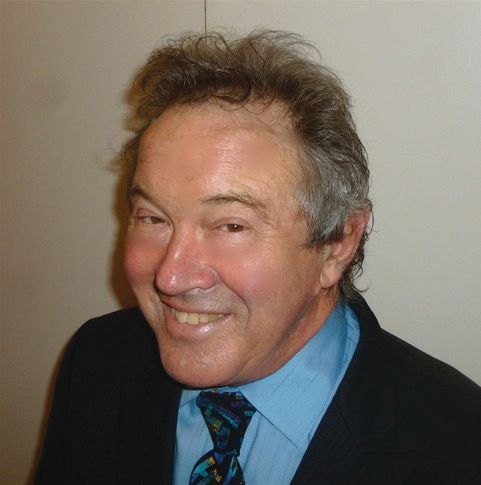
H. Steven Moffic, MD
Blue genu salivates with anticipation for the kill.
Dark vessels begging for mercy while lying still.
Tick-tock, tick-tock!
Blue genu consciously aware of lifeless prey.
Witnesses’ souls weep as they relive flashbacks of Freddie Gray.
Tick-tock, tick-track!
Blue genu imposes historical privilege to the black slain.
Dysphoric chocolate seeks justice for fatigued hearts bloodied with pain.
Tick-tock, tick-tock!
Tick-tock, tick-tock!
Black longevity has a premature clock.
-- Genuphobia by Frank Clark, MD
With one tick-tock, one of my patients’ lives was ended prematurely by the police.
I know psychiatrists are not supposed to have favorite patients, but I had one early in my career (1981). He was a young Black male with a diagnosis of schizophrenia who had been in and out of psychiatric hospitals for a few years. At that time, along with a Black male psychiatric resident, I was developing the first model curricula on cultural psychiatry. Thus, I was aware of the possibility of misdiagnosing that instead of, say, bipolar disorder.
He was charismatic and flamboyant, often acting as if he was in a karate class when he came to the clinic that I co-led with a Black female social worker. Maybe my racial countertransference was feeling entertained by his behavior. Did that lead me to not properly curtail that behavior?
One day, he was gesticulating in his karate way in front of a police station. This time, however, he was also holding a long knife. About 30 police came out and surrounded him. Yelling “Heil Hitler,” he made a move toward them and was shot dead. The case received national attention.
The good news is this event slowly but surely led the Houston Police Department to better understand and address mental health and racism, so much so that the department received awards for their work.
Unfortunately, improvement such as this is not widespread. I was triggered by the video of Elijah McClain. In 2019, right before he was choked to death by the police in Colorado, he said, “I’m an introvert. Please respect my boundaries.”20 They did not.
About a decade ago, I worked part-time in a medium security prison in Wisconsin. The prison population was overrepresented by young Black males diagnosed with untreatable sociopathy. However, once trust was established, it was clear most were suffering from treatable posttraumatic stress disorder. Whether from intergenerational transmission of trauma psychologically and/or epigenetically, these men were left vulnerable to being triggered to irritability, aggression, street drug usage, and the emergence of painful dissociated memories.
We must—and can—do better.
Visual Symbols of Racism
Rahn K. Bailey, MD

Rahn K. Bailey, MD
After World War II, when the Allied nations conquered Nazi Germany, all Nazi statues and monuments were destroyed. Why is there resistance to do the same in America? Nearly 700 remaining monuments of Confederate “heroes” stand as a reminder to African Americans of the slavery, bigotry, animosity, and the frank hatred that still exists today. There are also 109 public schools named after Confederate leaders, despite the fact that one fourth of students attending these schools are African Americans. Many in white America argue that these symbols represent their heritage. However, multiple studies show the primary factor of maintaining these symbols is racial resentment.21
For our country to truly heal, we must not glorify prior racist remnants. We must not embellish the symbols of white supremacy by encouraging their adverse racist principles. There has been some progress on this front. For instance, Governor Nikki Haley removed the Confederate flag after the 2015 shootings at the AME Church in South Carolina. New York State Senator Todd Kaminsky introduced a bill to include education on hate symbols and their effects in school curricula. There is a petition, once again, in Rhode Island to remove “Providence Plantations” from the official state name. This name, incidentally, is on every professional medical license, which is often hung on the walls in doctors’ offices and potentially noticed by Black patients.
We need everyday citizens and leaders to promote fairness, equity, and a greater sense of shared humanity across our nation.
Crucial and Productive Conversations About Racism
Aekta Malhotra, MD

Aekta Malhotra, MD
Borrowed from the management world, the term crucial conversations is one of many helpful communication tools when the stakes are high and emotions may get the best of us.
Alas, none of these tools will emancipate us from our intellectual cages or ease our psychological discomfort. Fortunately, British psychoanalyst Wilfred R. Bion, MRCS, LRCP, can help us in this endeavor. For instance, he wrote: “If the learner is intolerant of the essential frustration of learning he indulges phantasies of omniscience and a belief in a state where things are known.”22 Language that alienates, shames, and intimidates can be seen as a subconscious attempt to avoid the greater discomfort of challenging systems that oppress, while other individuals, prone to faltering as humans, become the subjects of our outrage. Bridging racial groups then becomes too uncomfortable.
As an Indian-American, I have faced plenty of racism in my personal and professional life. Yet, I have still been the beneficiary of privilege that is not afforded to my African American colleagues. I accept that with much humility. It is time we reframe systemic racism as not only a problem for those who have been oppressed, but rather a societal problem warranting solutions driven by those who have been the beneficiaries of the flawed systems. Because systemic racism has been interwoven in our lives for generations, we require active allyship to mitigate its effects. We collectively must find ways to become comfortable with being thrust into unfamiliar territory.
Examining Racial Blind Spots in Psychiatric Practice
Jessica Isom, MD, MPH

Jessica Isom, MD, MPH
As we are trained to drive, the importance of paying attention to blind spots on the road is constantly underscored. We are taught to acknowledge this phenomenon and make necessary corrective actions. Like drivers, psychiatrists have the ability to reposition themselves and their tools so as to avoid collisions, maintain safety, and continue on course.
Unconscious biases dominate our everyday life. Addressing unconscious bias, however, is not outside of our control.
As physicians, we are charged with mitigating the effects of racial bias so our behaviors may mirror our conscious egalitarian values. Unfortunately, we continue to do exactly the opposite in many cases, resulting in a racially inequitable health care system supported by racialized medical decision-making that burdens non-White patients. Race is one of the primary drivers of physician behaviors, and it has been shown to contribute to medical decisions, despite lack of a biological basis. Psychiatric training both nourishes and neglects unconscious racial bias by refusing to acknowledge its presence and dismissing its influence on medical judgement.
We must mitigate the impact of unjust racial biases on our practice of psychiatric medicine. Zestcott and colleagues.23 offers a starting point for reducing the influence of implicit bias on medical decision-making. Common-group, counter-stereotyping, and bias awareness opportunities (such as leveraging the Harvard Implicit Association Test) have shown promise in reducing the impact of implicit bias and/or increasing the motivation to do so.
Only by acknowledging the blind spots can we start to make meaningful course corrections.
Lifelong Education on Race in Psychiatry
Catherine Friedman, MD
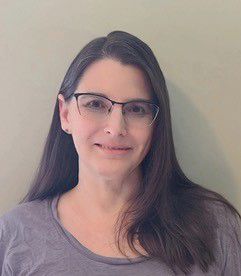
Catherine Friedman, MD
What baseline working knowledge of the impact of racism and others sociocultural factors on health is needed to be an effective psychiatrist in the United States?
Graduate and continuing medical education need to begin to address communication barriers caused by personal bias and ignorance. This process should include increased trainee and workforce diversity; required knowledge of and reflections on history and social sciences regarding race, and racism; diverse supervision; and explorations of unconscious bias.
Yet, graduate psychiatric training only captures psychiatrists for a short period at the beginning of their careers. Psychiatrists continue to practice for decades, and thus need refreshers and continuing education opportunities via formal and informal learning opportunities. Maintenance of Certification (MOC) requirements can and should provide tools, encouragement, and motivation for practicing psychiatrists to increase their understanding of race issues as well as guidance in working with people of diverse racial backgrounds. By increased knowledge and awareness with lived experiences, we afford more opportunities to make a difference.
Save the Children!
H. Steven Moffic, MD
“Could the police kill me, too?”16
These were the words of a 9-year-old Black male child in his parent’s care awaiting the start of a car-caravan protest. Inevitably, it seems, all the current racial trauma combined with the intergenerational transmission of trauma will psychologically harm our children’s future, especially Black children.
The challenges are many. How do we best talk to children about the trauma and the racism? To what should they be exposed? How can we prevent future posttraumatic symptoms and instead foster resilience and growth? We will need support, hope, and many uncomfortable talks.
I am reminded of the traditional Masai warriors greeting, “How are the children?” We know many are not fine.
A 2020 report looked at counties across the US to determine where children were most and least protected and prioritized.24 Specifically, the study looked at the factors that cut short childhood, including food insecurity, high school graduation rates, teenage pregnancy, and child homicide and suicide rates. Although results varied greatly across the country, Black and Native American children were overrepresented in the many poor counties. The authors noted, “This report uncovers an unacceptable reality in America, where one child can be exponentially more likely than another to succeed in life based solely on the county where they grow up.”
If things stay the way they are, will we ever be able to answer the Masai’s question with “They are well”?
Intersectionality in Psychiatry
Rahn K. Bailey, MD
“Intersectionality” refers to overlapping or interdependent systems of discrimination. It is a theoretical framework for understanding how various aspects of a person’s social and political identities might create unique vulnerabilities to discrimination. Race can be combined with gender, sexuality, class, nationality, ableism, and age. Using intersectionality as an analytic tool can shine a light on those who are most vulnerable to discrimination. Most likely, the more sociocultural differences each individual has, the more vulnerable they will be to discrimination, and the more difficulties they will endure.
A myriad of patients are similarly burdened with multiple issues that impact their mental health, which in turn can lead to anxiety, depression, substance abuse, and suicide. Thus, understanding intersectionality is essential for psychiatrists. It allows us to better understand our patients, their specific needs, and how best to manage their concerns for better outcomes, including offering crucial support for those who feel abandoned.
Racially Based Criminalization of Substance Abuse Disorders
Catherine Friedman, MD
For centuries, racial biases in communication have presented people of color as having inherent characterological deficits that make them seem irresponsible, lazy, and criminal. This has resulted in ideas of “weakness” and “depravity” when discussing substance misuse in this patient population.
In contrast, substance misuse by white individuals is more likely to be attributed to non-characterological traits, such as socioeconomic status, external environment, and mental health issues. This dichotomy manifests in the legal system, where Blacks are more likely to be arrested, jailed, denied bail, and charged with felonies than whites—although rates of drug use and selling/distribution are similar among both groups.
Similarly, crack cocaine possession (primarily used by Blacks) in the 1980s were associated with much harsher criminal penalties than powder cocaine possession (primarily used by whites). And, when opioid use disorder began to affect many whites in the 2000s, instead of seeing increased criminal penalties, a public health emergency was declared.
It is time we look at all substance use disorders as similar diseases and aim to address their root causes instead of penalizing people based on the substances commonly used by a select population.
Racial Lessons Learned in Rural Psychiatry
Claire Cohen, MD
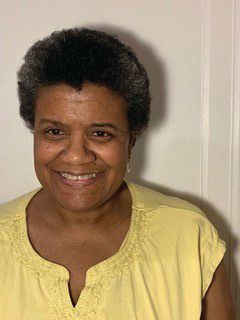
Claire Cohen, MD
As I sit here watching the demonstrations against racial oppression, I am flooded with feelings and thoughts of my experiences as a Black person, a Black woman, and a Black female psychiatrist practicing in Western Pennsylvania—in and around Pittsburgh and the edge of Appalachia.
I work with patients of all races and have gotten very positive patient reviews over the years. I tend to be stoic in the face of adversity. But sometimes I wonder if I partly rely on unhealthy denial to help deal with racism on the job.
Some of the things I have been told are jaw-dropping. I have patients and parents of patients who tell me I am the best doctor they ever had, and in the same breath they let me know they are glad I speak English. Or, they say that since I am Black, I understand what it is like to be down-and-out; or, they feel they can reveal their most embarrassing thoughts and actions to a Black doctor, but they want a White doctor who they are sure would be more competent. The scariest experience was when an agency that asked for my services told me they were sending me to areas where there are no psychiatrists to perform evaluations—and that they were sending someone to accompany me because “it is Klan country.”
In order to practice effectively and safely in rural areas that are vastly underserved, it is important to have better support.
Concluding thoughts
Because racism has been part of our country since its founding, it is everywhere and in everyone. Psychiatrists, in particular, should have the knowledge, attitudes, and skills to see where racism is hidden both externally and intrapsychically—in, for instance, symbols, terminology, aversive behavior, and micro-inequities—and then how to process it therapeutically.
We are encouraged by the work of anti-racism scholars who have outlined a strategic approach to shining light on racism. And, we encourage the reader to use this piece as a potential roadmap for your own personal journey in addressing racism in psychiatry and our nation. Since it is important to do this work systematically with mechanisms for accountability, we offer suggestions to measure outcomes and success levels (Table).
We represent a small group of psychiatrists with various staked interests in this subject. We acknowledge and honor the efforts of those valued experts before us and after us who have—and will—enrich the resources necessary for these efforts to be successful. Similarly, we recognize that your joining in this work is voluntary and important. We invite you to contact the authors should you wish to continue this discussion and share in the journey with us.
This article is dedicated to the memory of Representative John Lewis, who wisely said:
It is so strange to me that we have learned to fly in the air like birds, learned to swim in the ocean like fish, shoot a rocket to the moon, but we have not yet learned how to live together in harmony with one another.
Dr Moffic is an award-winning psychiatrist who has specialized in the cultural and ethical aspects of psychiatry. A prolific writer and speaker, he received the one-time designation of being a Hero of Public Psychiatry from the Assembly of the American Psychiatric Association (APA) in 2002. He has recently been leading Tikkun Olam advocacy movements on climate instability, burnout, Islamophobia, and Anti-Semitism for a better world. He serves on the Editorial Board of Psychiatric TimesTM. Dr Bailey serves as Assistant Dean of Clinical Education at Charles R. Drew University and Chief Medical Officer of Kedren Health Systems Inc. He served as president of the National Medical Association and chair of the American Medical Association’s Commission to End Health Disparities. He currently is a member of the American Psychiatric Association Board of Trustees. Throughout his career, Dr Bailey has worked with underserved and minority populations and has authored numerous papers on the topic. Dr Clark is Clinical Assistant Professor at the University of South Carolina School of Medicine-Greenville and Medical Director & Division Chief for Adult Inpatient and Consult-Liaison Services for the Department of Psychiatry and Behavioral Medicine at Prisma Health-Upstate. He currently serves on the APA Task Force to Address Structural Racism Throughout Psychiatry as well as the Advisory Board for Psychiatric TimesTM.
Dr Cohen is an African American child and adolescent psychiatrist who has been practicing in the Pittsburgh area since 1984. She has been an active advocate in her community throughout her career. Most recently, she has been involved in efforts to stop the school-to-prison pipeline on the Pittsburgh Public Schools and in fighting for Medicare For All as a member of Physicians For A National Health Program and the Western PA Coalition for Single Payer Healthcare. Dr Friedman is Assistant Professor at Brown Medical School and affiliated with Bradley and Rhode Island Hospitals. She works as a child and adolescent, addiction and adult psychiatrist. Dr Isom is voluntary faculty member in the Yale University Department of Psychiatry and currently an attending psychiatrist at Codman Square Health Center in Dorchester, MA as well as the Boston Medical Center Department of Psychiatry. She currently serves as a member of the APA Assembly and as a Councilor for the Massachusetts Psychiatric Society where her focus on racial justice and equity provides an opportunity to improve the care provided to marginalized populations in the state. She has continued to work with the Yale Department of Psychiatry in curriculum development and facilitation of the Social Justice and Health Equity Curriculum. Dr Malhotra is a recent graduate of the University of Massachusetts General Adult Psychiatry Residency Program. She serves on the Massachusetts Psychiatric Society’s Multicultural and Diversity Committee and is part of a core workgroup on addressing structural racism in medical and psychiatric training focusing on methodology, actionable steps, and measurement of outcomes.
References
1. American Psychiatric Association. The Principles of Medical Ethics, With Annotations Especially Applicable to Psychiatry. American Psychiatric Association; 2013.
2. Rush B. Medical Inquiries and Observations Upon the Disease of the Mind. Hafner Publishing Co; 1812/1962.
3. Griffith EEH, Jones B, Stewart A, eds. Black Mental Health: Patients, Providers, and Systems. American Psychiatric Association Publishing; 2019.
4. Campbell J. The Hero’s Journey: Joseph Campbell on His Life and Work. New World Library, third edition; 2014.
5. Shapiro A. NPR. What It is Like to Be a Young Black Doctor. June 25, 2020.
6. Fanon F. Black Sin, White Masks. Grove Press, revised edition; 2008.
7. Robcis C. Frantz Fanon, institutional psychotherapy, and the decolonization of psychiatry. J Hist Ideas. 2020;81(2):303-325.
8. Chugh D, Bock L. Person You Mean to Be: How Good People Fight Bias. HarperCollins; 2018.
9. Moffic HS, Kendrick EA, Reid K, Lomax J: Cultural psychiatry education during psychiatric residency. Acad Psychiatry. 1988; 12 90-101.
10. Bell C. Racism: A mental illness? Psychiatr Serv. 2004 Dec;55(12):1343.
11. Jones CP. Levels of racism: a theoretic framework and a gardener’s tale. Am J Public Health. 2000 Aug;90(8):1212-5.
12. Harford M. Some neuro-biologic determinants of intergroup bias that affect the development of Anti-Semitism. In: Moffic HS, Peteet H, Hankir A, Seeman M, eds. Anti-Semitism and Psychiatry. Springer International; 2020.
13. Kendi IX. Antiracist Baby. Kokila; 2020.
14. Noguchi Y. NPR. “Bear our pain”: The pleas for More Black Mental Health Workers. June 25, 2020.
15. Coates T-N. Letter to My Son. The Altantic. AccessedJuly 13, 2020.https://www.theatlantic.com/politics/archive/2015/07/tanehisi-coates-between-the-world-and-me/397619/
16. Eligon J. A debate Over Identity and Race Asks, Are African-Americans ‘Black’ or ‘black’? New York Times. June 26, 2020.
17. Gilroy P. Against Race. Belknap Press; 2002.
18. Robbins M. The primary process: Freud’s profound yet neglected contribution to the psychology of consciousness. Psychoanalytic Inquiry. 2018;38:3, 186-197
19. Grisham S. Medscape Psychiatrist Lifestyle Report in 2017: Race, Ethnicity, Bias, and Burnout, Medscape. 2017. Accessed July 10, 2020. https://www.medscape.com/features/slideshow/lifestyle/2017/psychiatry
20. Walker K, Smith C, Torres I, et al. What happened to Elijah McClain? Protests help bring new attention to his death. ABC News. Accessed July 1, 2020. https://abcnews.go.com/US/happened-elijah-mcclain-protests-bring-attention-death/story?id=71523476
21. Strother L., Piston S, Ogorzalek, T. Pride or prejudice?: Racial prejudice, southern heritage, and white support for the Confederate battle flag. Du Bois Review: Social Science Research on Race. 2017; 14(1):295-323.
22. Cristoff AJM. Linking with W.R. Bion:.Victorian Literature and culture. 2019;47(1):167-186.
23. Zestcott CA, Blair IV, Stone J. Examining the presence, consequences, and reduction of implicit bias in health care: A narrative review. Group Process Intergroup Relat. 2016 Jul;19(4):528-542.
24. Save the Children USA. The Land of Inopportunity: Closing the Childhood Equity Gap for American’s Kids. 2020.❒
